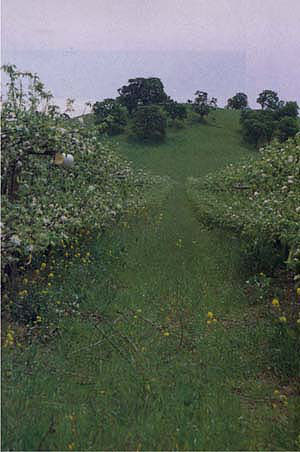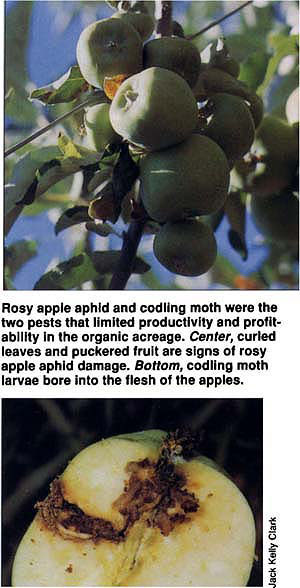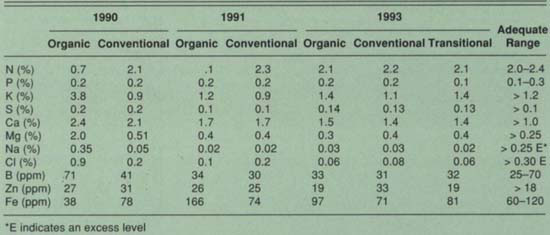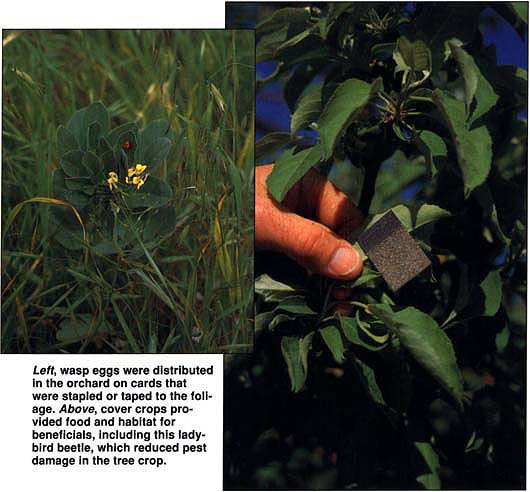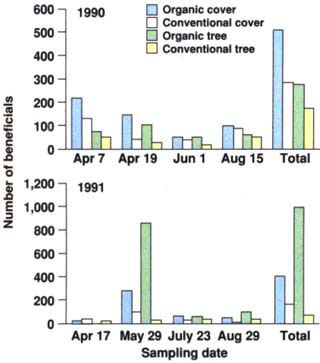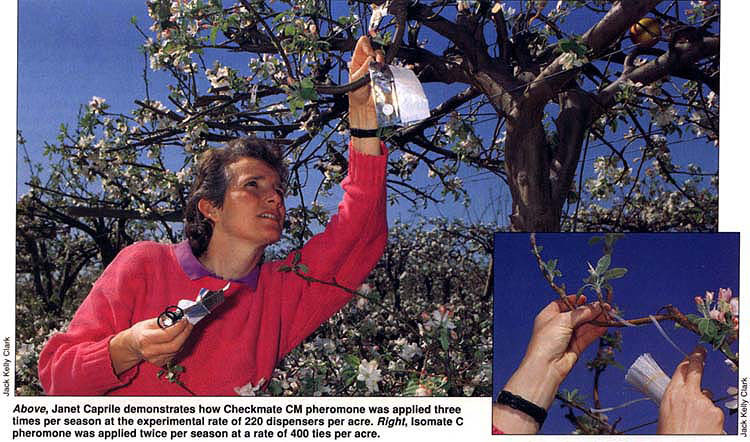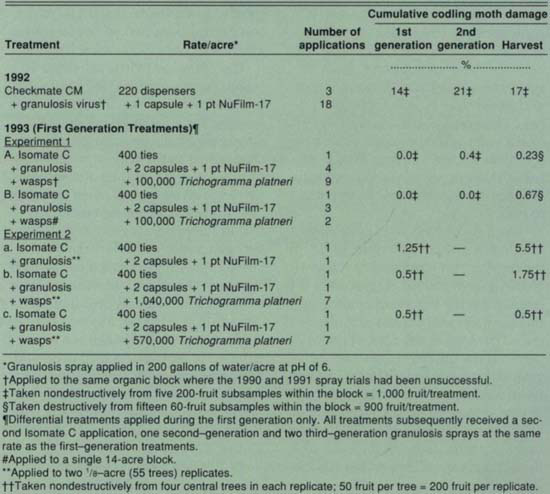All Issues
In Contra Costa County study, insect damage limits yield, profits of organic apples
Publication Information
California Agriculture 48(6):21-28.
Published November 01, 1994
PDF | Citation | Permissions
Abstract
Codling moth and rosy apple aphid limited production and profitability in the organic Granny Smith apple production system in the northern San Joaquin Valley. Over the course of this 4-year study, organic techniques were developed to control codling moth, but not rosy apple aphid, which is an occasional pest. Fertility was easily maintained in the organic system with leguminous cover crops, which also served as a habitat for insects beneficial to apple production.
Full text
Despite the recent interest in producing organically grown crops, little researcåah-based information has been developed to assist growers in this pursuit. This comparison study was begun in 1990 to develop a research base and to document some general differences between organic and conventional apple-production systems under northern San Joaquin Valley conditions. We monitored fertility and nutrition, pest incidence, beneficial insect activity and economics in the two systems in an observational fashion. In addition, we conducted a series of replicated trials to evaluate potential organic codling moth controls, because codling moth was perceived as the most limiting production problem for organic apple growers in this area.
The study site was located at Diablo Green Orchards in Brentwood, about 30 miles directly west of Stockton. The orchard is a fairly isolated 240-acre piece planted in 1986 to Granny Smith apples (440 trees per acre) on semidwarf (M 111) rootstock, and trained to a two-tier Ebro espalier system. The soil type is a Rincon clay loam. It is irrigated with a low-volume microsprinkler system.
In 1989 a portion of the orchard was converted to organic production. In 1990 we began monitoring this 11-acre organic block and an adjacent 26-acre conventional block. In 1993 an additional 14-acre block began the 3-year transition to organic production, and this “transitional” block was added to our comparison study for that year.
Soil fertility and plant nutrition
Nitrogen was the only nutrient that was supplied annually to both systems. In the conventional system, nitrogen was supplied by an application of commercial fertilizer in spring at rates of 50 to 100 pounds per acre. The rate was based on the results of the previous summer's leaf analysis.
In the organic system, nitrogen was supplied by a leguminous cover crop. In the fall of 1989 a subterranean clover mix was seeded, but resulted in a poor stand for the 1990 growing season. In subsequent seasons, bell or fava beans were planted under the tree canopy in the fall and mowed or lightly disked down in spring. Only the area reached by the micro-sprinklers was seeded so that the moisture from the microsprinklers could assist with the biomass breakdown and nutrient availability during the growing season.
Top, these comparison studies were done at Diablo Green Orchards, a 240-acre, Ebro trellised, semidwarf Granny Smith apple orchard in the northern San Joaquin Valley.
Rosy apple aphid and codling moth were the two pests that limited productivity and profitability in the organic acreage. Center, curled leaves and puckered fruit are signs of rosy apple aphid damage. Bottom, codling moth larvae bore into the flesh of the apples.
Plant nutrition and soil fertility were maintained in the organic system by the addition of bell beans to the cover crop of naturalized weeds.
Soil samples were collected in spring from the organic and conventional blocks in 1990, 1991 and 1993 and from the transitional block in 1993 (the study was not funded in 1992). We collected samples from the same four replicate locations in each block every year to reduce variability. In each replicate, we took samples from four depths (0 to 6 inches, 6 to 12 inches, 15 to 21 inches and 27 to 33 inches) in the primary root zone, taking care not to include visible cover crop residue in the sample; each sample consisted of a composite of five cores per depth. The comparative soil analysis in table 1 presents the profile averages. These averages are representative of the differences occurring at each depth.
The most noticeable soil differences between the two systems were the consistently higher organic matter (OM) content and cation exchange capacity (CEC) in the organic block. The organic block also had a higher salt content (electrical conductivity) than the conventional block. However, the high salt was more likely due to irrigation and block differences than to organic management techniques. The organic block had lower water pressure and less volume per unit time; compensation was made by running longer sets. However, it appears from the salt accumulation that the organic block was still receiving less water. The transitional block, with the same management practices, does not show a salt accumulation, but it does show similar OM and CEC increases. There were no apparent differences in texture or total nitrogen among the three blocks.
We monitored plant nutrient status by collecting leaf samples in July. The samples were collected from trees in the same four locations in each block from which the soil samples were collected. Each sample consisted of 100 fully mature leaves from nonfruiting spurs. The results are presented in table 2.
In 1990 poor cover crop establishment and a slight irrigation deficit in the organic block are reflected in low leaf nitrogen levels and high levels of other salts (K, Mg, Na, CI and B). Upon correction of these problems, plant nutrient status between the two systems became fairly comparable in subsequent years, with most nutrients falling in the adequate range. The notable exception was that the conventional system was slightly K deficient throughout the monitoring period, while the K levels in the organic and transitional systems were consistently higher and always within the adequate range. The organic system also had higher iron (Fe) and phosphorus (P) levels in some years, although the conventional levels were always within the adequate range. A spring 1993 zinc (Zn) application in the conventional system is reflected in higher Zn leaf levels that summer.
Cover crops, beneficial insects
There has been much speculation about the value of cover crops in reducing insect damage in orchards by providing food and habitat for beneficial insects. Two basic questions have surfaced from these discussions: Would beneficials attracted to a low-growing cover readily move to the tree canopy? And if they would move to the canopy, would they be effective in controlling insects important to crop production? Little research-based information is available to answer these questions and clarify the role of cover crops in orchard pest management. To address these issues, cover crop surveys and beneficial insect collections were conducted in 1990 and 1991.
Both the organic and the conventional systems had permanent cover crops of weeds, which were mowed periodically. Vegetation within the tree rows was controlled with an herbicide strip spray in the conventional system and a weeder bar in the organic system. Surveys of the cover crop plant species were conducted in the spring and summer of 1990 and 1991 to record the shift in species and coverage as the season progressed. A rating system of 0 to 5 was used to indicate the percent of the sample area covered by each species or by bare ground. In 1990, 20 separate plots (1.25 square feet each) were surveyed within each system. In 1991, 12 separate plots (700 square feet each) were surveyed in the organic system and three plots (700 square feet each) were surveyed in the conventional system.
Left, wasp eggs were distributed in the orchard on cards that were stapled or taped to the foliage. Above, cover crops provided food and habitat for beneficials, including this ladybird beetle, which reduced pest damage in the tree crop.
Fig. 1. The number of beneficials found throughout the season on the cover crop and the tree canopy in the organic and conventional systems.
Fig. 2. The seasonal totals for the various types of beneficials found on the cover crop and the tree canopy in the organic and conventional systems.
The number and type of plant species making up the cover crop were quite similar in both systems, with the exception of the clovers and the bell beans seeded in the organic block (table 3). As the season progressed, the species diversity decreased and the cover tended to thin out in the aisles in both systems, due to the limited coverage of the microsprinklers.
Beneficial insects were collected from both the cover crop and the tree canopy in the same locations where the cover crop survey had been conducted. In 1990 samples were collected with sweep nets from the ground cover and beating trays from the tree canopy. Ten sweeps or beats were collected from each of the 20 sample areas. In 1991 insect samples were collected by suction with a modified leaf blower in both the tree canopy and the cover crop. In each sample area, suction samples were collected from 15 1-meter-long sections of branch and from 12 1/4-square-meter samples of cover crop.
We found beneficials in both the organic and conventional systems (fig. 1). However, we typically found more beneficials in the organic than in the conventional system. The numbers depended on insect pressure as well as on the type and number of sprays. In both systems more beneficials were usually found in the cover than in the trees, unless there was an unusually high pest population (that is, food source) in the trees. For example, very high aphid populations in the organic system in May 1991 and high leaf miner populations in the conventional system in the summer of 1990 resulted in unusually high numbers of beneficials in the tree canopy, feeding on those pests. The number of beneficials collected decreased from spring to summer as the cover crop diversity and the percent cover decreased.
The beneficials found in the tree canopy were generally the same as those found in the cover crop, although some tended to favor one environment over the other (fig. 2). For example, ladybird beetles, big-eyed bugs, damsel bugs and aphid-controlling parasitic wasps were found more frequently on the orchard floor than in the tree canopy. Lacewings and the parasitic wasps that control leaf miners were found more frequently in the tree canopy. Pirate bugs, spiders and several other predators and parasites were found just as frequently on the cover crop as in the tree canopy.
Above, Janet Caprile demonstrates how Checkmate CM pheromone was applied three times per season at the experimental rate of 220 dispensers per acre. Right, isomate C pheromone was applied twice per season at a rate of 400 ties per acre.
These data show that the cover crop can indeed provide a valuable refuge for many types of beneficial insects in both organic and conventional systems. The combination of semidwarf trees and tall cover crop provided a continuum of vegetation from the ground to the tree canopy, and may have contributed to the migration of beneficials from the cover to the trees.
The beneficial insects were generally successful in controlling leaf miners, mites and aphids (in some years), but not codling moths. Although some predation of codling moth did occur in the orchard, it was insufficient to prevent economic damage. This is consistent with the significant codling moth damage observed in abandoned apple orchards throughout the state. Most organic apple growers must employ additional means to control this pest.
TABLE 6. Effect of mating disruption and supplemental organic codling moth treatments in 1992 and 1993
Codling moth organic spray trials
We evaluated five organic sprays in 1990 and 1991 for their ability to control codling moth (table 4). Treatments were arranged in a randomized complete block design (except where noted), with three 1/3-acre (125 tree) replicates. Sampling was done on the eight central trees in each replicate. All spray treatments were applied at 7-day intervals during the estimated hatchout period for each generation. Fifteen applications were made in 1990, and 19 were made in 1991. Spray coverage was checked periodically with water-sensitive cards. Codling moth damage was recorded at the end of each generation by examining 100 fruit per replicate (300 per treatment) and at harvest by examining 200 fruit per replicate.
In 1991 two additional treatments were employed to control codling moth: thinning fruit to enhance organic spray coverage and effectiveness; and bagging fruit as a replacement for the organic sprays. Each spray treatment had a thinned and an unthinned row. Number 2 brown paper bags were applied at thinning time to all the trees in two of the three control plots, except for the central eight trees. Three hundred fruit were evaluated for damage in each treatment at harvest.
There was a high level of damage, ranging from 10 to 51% damage, in all the organic spray treatments (table 4). None of them proved significantly different from the untreated control, although there was a trend toward reduced damage in the Bacillus thuringiensis (Bt) + oil, oil, ryania and granulosis treatments. The lack of significance may be due to the high variability among replicates, especially in 1991. The Bt treatment in 1990 had significantly more damage than any of the other sprays. This and the similarity in damage between the Bt + oil and the oil sprays in 1991 indicated that any control was due to the oil rather than to the Bt.
Thinning did not improve the effectiveness of any of the 1991 spray treatments (table 5). Bagging the fruit greatly reduced codling moth damage. However, the time (432 person hours per acre) and the expense (about $3,000 per acre) limit the feasibility of this practice for most commercial operations.
Codling moth pheromone trials
In 1992 the entire 11-acre organic block was treated with a codling moth mating-disruption product. Because the codling moth population was quite high and significant egg laying was observed during the first generation, the block was oversprayed with granulosis virus every week during hatchout. Granulosis virus was selected over the other organic spray materials because it is easier to apply than ryania and has less phytotoxic danger than oil. The volume was increased to 200 gallons per acre, the adjuvant was changed to NuFilm-17 and the pH was dropped to 6. We examined 900 to 1,000 fruit in five locations (northern, southern, eastern, western and central portions) within the block after each generation and at harvest.
The granulosis virus provided excellent control under these conditions (table 6). Most larvae did not survive past the early instar stages, so the damage from subsequent generations diminished as the season progressed. This is a reversal of the pattern that we saw in previous years, when the damage from each generation exceeded that of the previous generation. In the first generation, 14% damage occurred. Only half as much damage occurred in the second generation, for a total of 21%. No additional damage occurred during the third generation; the slight decrease in damage can be attributed to late-season fruit drop and sampling error. The cumulative damage at harvest was less than half that of the previous year's spray trial, and the resident population appeared to be almost eliminated.
In 1993 a different combination of granulosis virus and Trichogramma platneri wasps (a codling moth egg parasite) were employed during the first codling moth generation in two separate experiments to supplement the pheromone confusion program. Seasonal treatments are fully described in table 6. Experiment 1 was a large-scale observational trial using 8 acres of the 11-acre organic block and the adjacent 14-acre transitional block. During the first generation the organic block received four granulosis sprays and nine wasp releases, while the transitional block received only three granulosis sprays and two wasp releases. We examined 900 to 1,000 fruit after each generation and at harvest; examinations were made in five locations (northern, southern, eastern, western and central portions) within each treatment area.
The second experiment was a smaller trial of 1/8-acre plots established in a portion of the organic block not included in the first experiment. We released three different rates of wasps (0, 570,000 and 1,140,000 wasps per acre) at weekly intervals during the first generation. Each treatment also received one granulosis spray toward the end of the first generation. Treatments were replicated twice. We examined 200 fruit from the four central trees in each replicate after the first generation and at harvest.
Both experiments were treated with a mating disruption product throughout the season and were oversprayed with granulosis virus once during the second generation and twice during the third generation.
The observational treatments in the first experiment performed similarly and kept damage below 1% at harvest (table 6). In experiment 2, where wasps were used as the primary control during the first generation, results were acceptable, but variable; the low and high release rates did not appear to reflect the degree of codling moth control. Where no wasps were released, the damage exceeded 5%. These preliminary experiments show some promise for using augmentative releases of Trichogramma platneri as a supplement for pheromone confusion to control codling moth.
Other pests and problems
We conducted routine pest monitoring throughout the season, and determined fruit damage from all causes at harvest (fig. 3). In 1990 and 1991, we collected a 200-fruit subsample from each codling moth spray replicate (600 per treatment) and graded for single defects in 1990 and multiple defects in 1991. In 1993, we collected 60 fruit from 15 subplots within each treatment (900 per treatment) and graded them for multiple defects and packout categories (Extra Fancy, Fancy, Cull).
In 1990, 44.5% of the fruit from the combined organic treatments was culled; the primary cause was codling moth. Other defects may be artificially low, because only single defects were recorded and codling moth was the first defect recorded. The conventional block lost 20.1% of fruit, primarily due to sunburn. No other serious pest problems occurred in either system that year.
TABLE 8. Comparison of per acre costs and returns for Granny Smith apples in the organic and conventional systems
In 1991 the fruit loss at harvest, based on the weight of all culled fruit, was 65.8% in the combined organic spray treatments versus 45.5% in the conventional system. The primary causes of loss in the conventional system were sunburn and russeting (from persistent rains during bloom). There was much greater damage from codling moth and rosy apple aphid in the organic system. The organic system also had a slightly lower sunburn loss, which may be attributed to lower leaf miner damage. The organic system had greater parasitization of and less damage from leaf miner in all years (table 7).
In 1993 the fruit loss at harvest from all combined organic treatments was 21%, versus 7.9% in the conventional system. The primary reason for the increased loss in the organic system was rosy apple aphid damage and undersize fruit.
In addition, a survey of dropped fruit indicated that much of the damaged fruit was dropped prior to harvest. Thus the aphid damage recorded in the harvested fruit underestimated the actual damage caused by this pest. The percentage of aphid-damaged fruit in June, taken before fruit drop and when shoot damage was highly visible, is a better representation of the actual extent of aphid damage (table 7).
Economics
Economic data were obtained from the grower's computerized records and inserted into a standard cost study format (table 8).
In 1990 the packed organic fruit received an average premium of 27%, while the expenses for the organic system were slightly less than for the conventional system. However, these advantages did not offset the 53% reduction in the number of organic boxes produced; the net returns for the organic system were negative, while the conventional system averaged a $500 per acre return.
In 1991 the packed organic fruit received an average premium of 49% and the expenses were similar to the conventional system. However, the organic system yielded 80% fewer boxes than the conventional system due to codling moth and rosy apple aphid damage. The price premiums did not make up for the yield losses; the organic system just covered expenses while the conventional system had more than a $3,400 per acre profit.
By 1993, the organic yields had greatly improved due to a more successful codling moth management program; almost 80% of the fruit was packed. Gross organic returns were much higher than conventional returns due to favorable organic price premiums, an innovative organic marketing strategy and generally low market prices for conventionally packed Granny Smith apples. Even though the expenses in the organic system were higher than in the conventional system, net profit for the organic system was over $3,600 per acre, while that for the conventional system was negative.
Conclusions
Fertility and pest management practices are the primary differences between organic and conventional apple production systems. In this study, under northern San Joaquin Valley conditions, plant nutrition in the organic system was adequately maintained through the use of leguminous cover crops. In addition, the organic system had a higher soil organic matter content and cation exchange capacity and a higher leaf potassium level than the conventional system.
Codling moth (1990, 1991 and 1992) and rosy apple aphid (1991 and 1993) were the two pests that significantly reduced apple yields and quality in the organic system compared to the conventional system. Organic sprays, used alone, were not effective in reducing codling moth damage to acceptable levels. However, mating disruption, supplemented by sprays of granulosis virus and trichogramma wasp releases, brought codling moth pressure down to the conventional system levels.
In general, cover crops enhanced the number of beneficial insects in the tree canopy. In 1990, lacewings, ladybird beetles and other beneficials were abundant in the organic orchard throughout the spring and kept aphid populations to an acceptable level. In 1991, these beneficials were not as abundant in early spring, perhaps due to unusually cool weather, and aphid populations built up to extremely damaging levels. Weekly soap and/or pyrellin sprays were unsuccessful in reducing damage. More research is being conducted in this area.
During the first two years of this study, the higher prices obtained for organic apples did not offset the yield and quality reduction due to pest damage. By the fourth year, more successful codling moth management, coupled with an innovative marketing approach and favorable price premiums, resulted in the first year of favorable returns for the organic system. The poor price for conventional apples that year made the success of the organic system all the more dramatic. Despite the favorable organic returns during the last year, there is a great financial risk associated with organic production as the future success of pest control strategies as well as market share and strategies are still uncertain.



